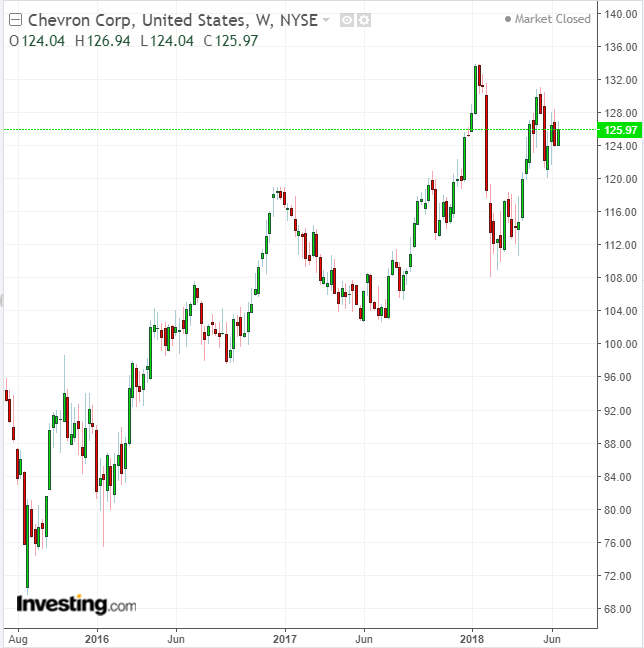Investing in big oil stocks has never been simple. It’s almost impossible to predict the direction of energy markets. Many top forecasters have tried to get this right but have failed miserably.
Picking the right stock from the group of energy giants trading on US indices has become more complicated since the collapse of energy market prices in 2015-2016. There’s also been increasing uncertainty over the future of oil and gas given the rise of renewables, electric cars, and a global push to curb climate change. Plus OPEC/non-OPEC driven production cuts and increases add to the volatility.
Nevertheless, shares of two of the US's 'supermajors' in this space, ExxonMobil (NYSE:XOM) and Chevron (NYSE:CVX), have traditionally provided investors with stable dividend income and moderate capital gains. Which stock offers better long-term prospects right now?
ExxonMobil: Struggling Giant
Over the past 5 years, among experienced investors, ExxonMobil stock has lost its allure. The company's shares diverged from other big oil stocks, falling about 10% during the past two years when Chevron, for example, surged by 24%.

The biggest challenge this supermajor faced during this period was how to boost its output during one of the worst oil slumps, something that began in 2014. Exxon’s production has dropped in five of the last six years. In April, the company posted its worst first-quarter production figures since Exxon merged with Mobil in 1999.
To counter this slump and improve its long-term outlook, Exxon is undertaking a massive $200-billion expansion project over the next seven years. The company plans to invest heavily in low-cost mega-projects that will help it maintain its dominance in oil and natural gas markets for decades to come.
As part of this plan, Exxon will increase its minimal oil production in the U.S. Permian Basin five-fold, and start up 25 projects worldwide, which will add more than 1 million oil-equivalent barrels per day to the company's production volume. In 2017, ExxonMobil added 10 billion oil-equivalent barrels to its resource base in locations including the Permian, Guyana, Mozambique, Papua New Guinea and Brazil.
If all this materializes and the price of oil remains around $60 a barrel, Exxon’s management expects the company will be able to double earnings by 2025. It reported $4.65 billion in net income for the quarter that ended in March.
But that bet might backfire, particularly since many analysts are calling for oil demand to peak in the next 10 to 15 years due to rising use of electric cars and the global push to invest in renewable energy sources and cut back on carbon emissions.
According to BP (NYSE:BP), one of the world’s largest oil producers, self-driving electric vehicles will cause a revolution in transportation over the next two decades, leading global oil demand to peak by the late 2030s. The forecast marks the first time BP has shown oil consumption peaking in its long-term forecasts but the UK group said it saw little risk of a precipitous decline in demand.
Chevron: A Different Approach
While Exxon is on a spending binge, Chevron has taken a different approach. The company is keeping its spending low and trying to squeeze more juice from existing assets. According to management, it intends to maintain low levels of capital spending ($18 billion to $20 billion annually) from 2018 to 2020.
Chevron estimates it will grow production by 4-7% annually between 2017 and 2020. Indeed, it appears the company’s short-term plan is working. In the first quarter, Chevron surpassed every profit and production estimate, raising the possibility of a resumption of share buybacks later this year, something that was suspended in 2015.

The company also pumped more crude and natural gas than observers anticipated. Chevron earned $1.90 a share during the first three months of the year, exceeding the $1.47 average of analysts’ consensus estimates.
In order to appease investors, CEO Mike Wirth hinted in April that he would consider resuming the company’s share buybacks, a move which has fueled gains in its share price. Exxon, on the other hand, has expressed a preference to increase spending on major oil and gas projects over buying back shares.
Which Is A Better Bet?
It’s not difficult to see that investors aren't excited about Exxon’s long-term growth strategy. Clearly they see a lot of risks going forward in this uncertain demand and supply environment. Since Darren Woods became the CEO of Exxon in 2017, shares has fallen 8%, closing yesterday at $80.82, compared with an 8% gain for its biggest American rival, Chevron which yesterday closed at $125.97.
That said, I think both Exxon and Chevron are great dividend stocks with a terrific income appeal for long-term investors. Exxon’s dividend yield after a recent pullback in its share price is over 4%, the highest level since mid-1990s; Chevron's yield is only marginally lower, currently 3.61%.
If you’re a long-term investor and want to have some exposure to oil stocks, the truth is we like both Exxon and Chevron, despite their different paths to achieving growth. Each has a rock-solid balance-sheet and low-level of long-term debt. To be honest, we don’t see an investor going wrong by picking either of these giants.
Despite recent sluggishness, Exxon shares have rewarded investors handsomely over the long run. They’ve provided a total return of 1,654% over the past 30 years, more than 400 percentage points higher than the S&P 500 Energy Index.
